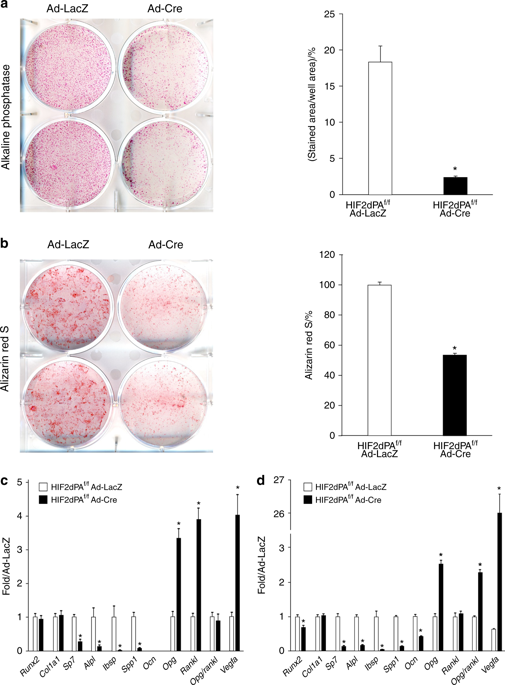Bone Research ( IF 14.3 ) Pub Date : 2019-02-21 , DOI: 10.1038/s41413-019-0045-z Christophe Merceron 1 , Kavitha Ranganathan 1, 2 , Elizabeth Wang 1 , Zachary Tata 1 , Shreya Makkapati 1 , Mohd Parvez Khan 1 , Laura Mangiavini 1 , Angela Qing Yao 1 , Laura Castellini 3 , Benjamin Levi 2 , Amato J Giaccia 3 , Ernestina Schipani 1

|
Osteoblasts, which are the bone-forming cells, operate in a hypoxic environment. The transcription factors hypoxia-inducible factor-1α (HIF1) and HIF2 are key mediators of the cellular response to hypoxia. Both are expressed in osteoblasts. HIF1 is known to be a positive regulator of bone formation. Conversely, the role of HIF2 in the control osteoblast biology is still poorly understood. In this study, we used mouse genetics to demonstrate that HIF2 is an inhibitor of osteoblastogenesis and bone mass accrual. Moreover, we provided evidence that HIF2 impairs osteoblast differentiation at least in part, by upregulating the transcription factor Sox9. Our findings constitute a paradigm shift, as activation of the hypoxia-signaling pathway has traditionally been associated with increased bone formation through HIF1. Inhibiting HIF2 could thus represent a therapeutic approach for the treatment of the low bone mass observed in chronic diseases, osteoporosis, or aging.
中文翻译:

缺氧诱导因子 2α 是成骨细胞生成和骨量增长的负调节因子
成骨细胞是骨形成细胞,在缺氧环境中运作。转录因子缺氧诱导因子-1α (HIF1) 和 HIF2 是细胞对缺氧反应的关键介质。两者均在成骨细胞中表达。已知 HIF1 是骨形成的正调节因子。相反,HIF2 在控制成骨细胞生物学中的作用仍然知之甚少。在这项研究中,我们使用小鼠遗传学来证明 HIF2 是成骨细胞生成和骨量增长的抑制剂。此外,我们提供的证据表明,HIF2 通过上调转录因子 Sox9 至少部分损害成骨细胞分化。我们的研究结果构成了范式转变,因为缺氧信号通路的激活传统上与通过 HIF1 增加骨形成有关。因此,抑制 HIF2 可能代表一种治疗慢性疾病、骨质疏松症或衰老中观察到的低骨量的治疗方法。











































 京公网安备 11010802027423号
京公网安备 11010802027423号